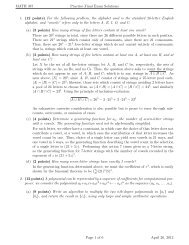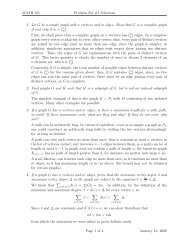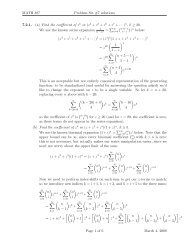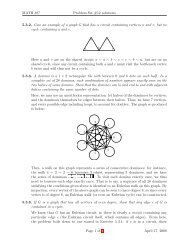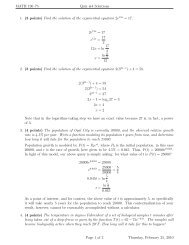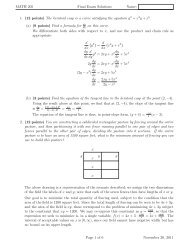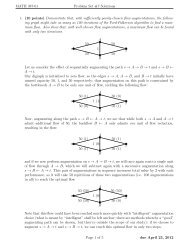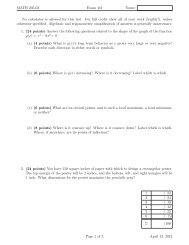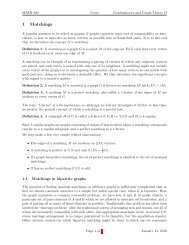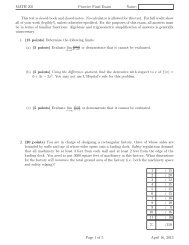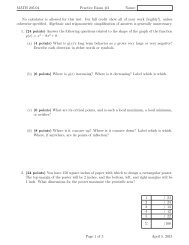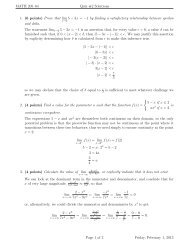MATH 681 <strong>Notes</strong> Combinatorics and Graph Theory IPro<strong>of</strong>. Suppose C ⊂ P is a maximal chain, Since (C, ≼) is a finite nonempty poset in its own right,it has some maximal element x; since C is totally ordered, the nonexistence <strong>of</strong> any y in C such thatx ≼ y implies that y ≼ x <strong>for</strong> all y ∈ C, so x is in fact a greatest element <strong>of</strong> C (if not necessarily <strong>of</strong>S). We have two possibilities to address: x may be maximal in S, or it may not. If it is maximal,our condition has been shown. If it is not maximal, there is a z ∈ S such that x ≼ z. Then, <strong>for</strong> ally ∈ C, y ≼ x ≼ z, so y ≼ z, so C ∪ {z} is totally ordered, contradicting C’s maximality. The pro<strong>of</strong><strong>for</strong> minimal elements proceeds along similar lines.Proposition 2. The set <strong>of</strong> maximal elements <strong>of</strong> a finite poset S is a maximal antichain; likewise,the set <strong>of</strong> minimal elements <strong>of</strong> a finite poset S is a maximal antichain.Pro<strong>of</strong>. Note that this is trivially true if S is empty; hence<strong>for</strong>th, we will consider the case where Shas at elast one element.Let A be the set <strong>of</strong> maximal elements <strong>of</strong> S. We shall first prove that A is an antichain, and thenthat any augmentation <strong>of</strong> A by adding an element is not an antichain.Consider distinct elements x, y ∈ A. Since x is a maximal element and y ≠ x, maximality guaranteesx y, Likewise, since y is maximal anddistinct from x, y x. Thus, x and y are incomparable.Since this is true <strong>of</strong> arbitrarily chosen distinct elements <strong>of</strong> A, all distinct elements <strong>of</strong> A are incomparableand A is an antichain.Now, consider z 0 ∈ S −A; that is, z 0 is a non-maximal element <strong>of</strong> S. We shall show that A∪{z 0 } isnot an antichain. Since z 0 is nonmaximal, there is some z 1 ≠ z 0 such that z 0 ≼ z 1 . If z 1 is maximal,it is in A; if it is nonmaximal, there is a z 2 ≠ z 1 such that z 1 ≼ z 2 . We continue along these linesuntil we get either a z k that is maximal, or an infinite ascending sequence z 0 ≼ z 1 ≼ · · · . Thelatter situation was shown last <strong>week</strong> to be impossible in a finite poset; thus some z k is maximal, soz k ∈ A and z 0 ≼ z 1 ≼ · · · ≼ z k gives z 0 ≼ z k by transitivity. Since z 0 and z k are comparable, andz k ∈ A, A ∪ {z 0 } is not an antichain.The pro<strong>of</strong> <strong>for</strong> minimal elements proceeds along similar lines.1.2 Limits on width and height; Dilworth’s TheoremOne interesting result we see playing with maximum chains and antichains is that they can’t both bevery small. We can easily build posets with large height and small width (e.g. ({1, 2, 3, . . . , n}, ≤)),small height and large width ({1, 2, 3, . . . , n}, =), and even with large height and width ({a 1 , a 2 , a 3 , . . . , b 2 , b 3 , . . . b n },) with a i ≼ a j when i ≤ j, and all other terms incomparable. But keeping both the height andwidth <strong>of</strong> an arbitrarily large poset down seem hard (we can kind <strong>of</strong> do so, with {1, 2, 3, n} 2 subjectto (a, b) ≼ (c, d) if a ≤ c and b = d – this has n 2 elements and length and width <strong>of</strong> n.We shall show that this is in fact the best we can do.Proposition 3. Suppose P is partitioned into a finite set <strong>of</strong> chains C 1 , C 2 , . . . , C n . If A is anantichain, then there is at most one element <strong>of</strong> A in each C i ; thus n ≥ |A|.Pro<strong>of</strong>. This result is actually quite trivial: suppose two distinct elements x and y <strong>of</strong> A were bothin the same chain C i . membership in A would <strong>for</strong>ce x and y to be incomparable; membership inC i would <strong>for</strong>ce them to be comparable. Thus, |A ∩ C i | ≤ 1 <strong>for</strong> all i.Page 2 <strong>of</strong> 5 November <strong>19</strong>, 2009
MATH 681 <strong>Notes</strong> Combinatorics and Graph Theory IWe thus know that any antichain has size no more than the size <strong>of</strong> any partition <strong>of</strong> the underlyingposet into chains. However, if we take the largest antichain possible, and the smallest chain-partitionpossible, this inequality becomes an equality:Theorem 1 (Dilworth <strong>19</strong>48, Galvin <strong>19</strong>94). If A is a largest antichain in a finite poset (S, ≼), thenthere is a partition <strong>of</strong> S into chains C 1 ∪ C 2 ∪ · · · C n such that n = |A|. Furthermore, each C icontains exactly one element <strong>of</strong> A, and there is no partition <strong>of</strong> S into fewer than n chains.Pro<strong>of</strong>. We will prove this by induction on |S|. In the base-cases |S| = 0 or |S| = 1, A = S withtrivial associated chain-partitions. We shall thus proceed with an inductive step on |S| ≥ 2.Let x be a maximal element <strong>of</strong> S. (S − {x}, ≼) is a poset with |S| − 1 elements, so by the indictivehypothesis, given that S − {x} has width k, S − {x} has a partition into chains C 1 ∪ C 2 ∪ · · · C k ,and some finite number <strong>of</strong> antichains A 1 , A 2 , . . . , A r <strong>of</strong> size k. By the proposition above, eachintersection C i ∩ A j consists <strong>of</strong> at most one element, and since (C 1 ∪ C 2 · · · ∪ C n ) ∩ A j = k,eachintersection consists <strong>of</strong> exactly one element. Thus, we may denote C i ∩A j = {a ij }. Let a i = max j a ij(note: since all the a ij ∈ C j , a totally ordered set, all elements are comparable, and a maximumamong them is a well-defined concept), and let A ′ = {a 1 , a 2 , . . . , a k }.First, we must prove that A ′ is itself an antichain. Consider two elements a i and a i ′ <strong>of</strong> A ′ . Bythe construction <strong>of</strong> a i , these will be some a ij and a i ′ j ′ respectively. Then, since a ij = max k a ik , weknow that a ij ′ ≼ a ij . Since a ij ′ and a i ′ j ′ are both in A j ′, they are incomparable. Thus, a ij a i ′ j ′,since if it were so, we would have the transitive comparison a ij ′ ≼ a ij ≼ a i ′ j ′. We may similarlyshow that a i ′ j ′ a ij, so a i and a i ′ are incomparable, so A ′ is an antichain.Now that we have constructed an antichain in S − {x}, we have two cases to deal with:Case I: x is incomparable to every element <strong>of</strong> A ′ . Then A = A ′ ∪ {x} is an antichain. Itis clearly a maximum antichain, having size k + 1, since if S contained an antichain <strong>of</strong> size k + 2or larger, then removal <strong>of</strong> x from the antichain would yield an antichains in S − {x} <strong>of</strong> size k + 1,which would be impossible. Thus A = A ′ ∪ {x} and the chain-partition S = C 1 ∪ C 2 ∪ · · · ∪ C k ∪ {x}would satisfy the conditions <strong>of</strong> the theorem.Case II: x is comparable to some element <strong>of</strong> A ′ . There is some a i ∈ A ′ such that a i andx are comparable. Since x is maximal, x a i , so instead, the comparison between x and a i isa i ≼ x. By the definition <strong>of</strong> a i , a i is the largest element <strong>of</strong> C i lying in any antichain <strong>of</strong> size kin S − {x}. Now, let us consider C = {a i1 , a i2 , . . . , a ir } ∪ {x}, with a ij as defined above. Since{a i1 , a i2 , . . . , a ir } ⊆ C i , it is a chain, and since every a ij ≼ a i ≼ x, C will be a chain as well. Now,let us consider the poset (S − C, ≼). It contains no antichains <strong>of</strong> size k, because every antichainA j <strong>of</strong> size k in S − {x} contained an element a ij <strong>of</strong> C; however, it contains several antichains <strong>of</strong>size k − 1, since each A j − {a ij } lies in S − C. Thus, by the inductive hypothesis, since S − C hasa width <strong>of</strong> k − 1, S − C is decomposable into a partition <strong>of</strong> k − 1 chains C 1 ′ ∪ C′ 2 ∪ C′ 3 · · · ∪ C′ k−1 .Then, S has decomposition into k chains C 1 ′ ∪ C′ 2 ∪ C′ 3 · · · ∪ C′ k−1∪ C. By the proposition above,this means no antichain in S has more than k elements, so A = A ′ is a maximum antichain.We get some rather nice results from this:Corollary 1. If |S| > mn, then S has either height <strong>of</strong> at least m + 1 or width <strong>of</strong> at least n + 1.Pro<strong>of</strong>. Suppose the longest chain in S is <strong>of</strong> size k, and the largest antichain is <strong>of</strong> size l. ByDilworth’s Theorem, S is partitionable into l chains C 1 , C 2 , . . . , C l . Since they <strong>for</strong>m a partition<strong>of</strong> S, |C 1 | + |C 2 | + · · · + |C l | = |S|; since the largest chain in S is <strong>of</strong> size k, we know each |C i | ≤ k,Page 3 <strong>of</strong> 5 November <strong>19</strong>, 2009




